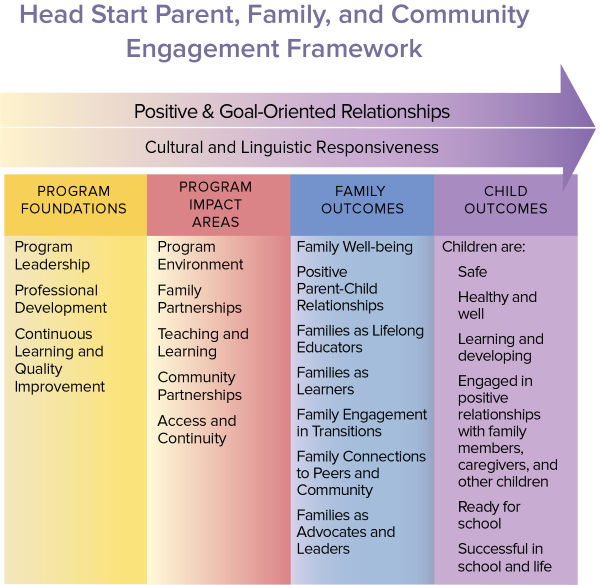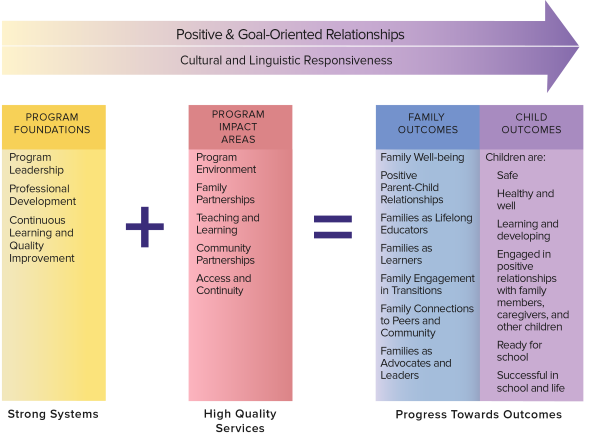In this resource, "parent" and "family" refer to all adult caregivers who interact with early childhood systems in support of their child. These caregivers include biological, adoptive, and foster parents; pregnant women and expectant families; out-of-household parents; grandparents; legal and informal guardians; adult siblings; and other family members.
Family services are central to the comprehensive services provided by Head Start programs to promote the well-being of families with young children. Head Start programs implement a holistic, two-generation approach to working with children and families. This approach accounts for the needs of both children and their families. In Head Start programs, we view parents as their children’s first teachers and a program’s most important partners. This feature of Head Start programs sets it apart from many other early childhood programs. Family services professionals advance and nurture family engagement in Head Start programs and create links to important, two-generation supports.
 Family engagement is an interactive process through which program staff and families, family members, and their children build positive and goal-oriented relationships. It is a shared responsibility of families and professionals that requires mutual respect for the roles and strengths each has to offer. Family engagement means doing with — not doing to or doing for — families. High-quality family engagement is responsive to families' cultures and languages.
Family engagement is an interactive process through which program staff and families, family members, and their children build positive and goal-oriented relationships. It is a shared responsibility of families and professionals that requires mutual respect for the roles and strengths each has to offer. Family engagement means doing with — not doing to or doing for — families. High-quality family engagement is responsive to families' cultures and languages.
Over the past decade, family services staff and families have played key roles in creating more meaningful, systemic, integrated, and comprehensive approaches to family engagement. As a result of these efforts, family engagement today is intentional, specific, rigorous, and measurable.
Why is this important? We want our work with families to make meaningful impacts. Together, with your support and expertise, families make progress toward the dreams they hold for themselves and their children. The impact of your work doesn’t stop there. As you will see in the next section about the Parent, Family, and Community Engagement (PFCE) Framework, your contributions also guide the program and make important connections across community partners.

Head Start PFCE Framework
The Head Start Parent, Family, and Community Engagement Framework provides a road map for family services professionals and all Head Start staff and leaders to advance their family engagement work. It helps us to better partner with families in making progress toward family and child outcomes. This framework is an important reference point for everything you do in your role in Head Start programs. It is a resource to return to again and again.
The goal of family engagement is to build strong and effective partnerships with families to help them and their children thrive. These partnerships are grounded in positive, goal-oriented relationships with families.
Positive and Goal-oriented Relationships and Cultural, and Linguistic Responsiveness (the arrows across the top of the entire PFCE Framework graphic) are central driving forces for your work with families and children. Successful relationships focus on families’ strengths and a shared commitment to each child’s well-being and success. Positive, goal-oriented relationships develop over time. They are created through ongoing interactions among families and staff in Head Start programs.
Our interactions with families become richer and more authentic when we learn about who families are. This requires us to understand and respect each family’s cultures, beliefs, languages, lifeways, hopes, and dreams. This approach promotes relationships that:
- Are fueled by families’ passion for their children
- Are based on mutual respect and trust
- Affirm and celebrate families’ cultures and languages
- Provide opportunities for two-way communications
- Include authentic interactions that are meaningful to those who participate in them
- Make space for different perspectives and how they affect mutual respect and trust in the relationship.
Focus your partnership efforts with families on making progress toward one or more of the seven Family Outcomes listed in the PFCE Framework. The Family Outcomes are based on research, practice, and the common experiences of families, children, and staff. These outcomes align with the Performance Standards, Family partnership services, 45 CFR §1302.52, they are meaningful to families, and they influence outcomes for children.
Family Outcomes can also guide your work with families to identify their immediate and future goals for themselves and their children. As you engage in self-reflection, ask yourself these questions:
- How does my work with families foster their progress toward the goals they set for themselves?
- How can I partner with families to help them see connections between the goals they set for themselves and the Family Outcomes column of the PFCE Framework?
- How can I help families think about how their family goals connect with outcomes or goals for their child?
 Program Foundations and Program Impact Areas are the first two columns of the PFCE Framework. Together, they include seven elements essential to successful family engagement. When programs infuse each of these elements into their work through a systemic, integrated, and comprehensive approach, all efforts can better lead to enhanced family and child outcomes. Family services managers often see their work in the Program Foundations column of the framework. Family services staff usually see their work in the Program Impact Areas column.
Program Foundations and Program Impact Areas are the first two columns of the PFCE Framework. Together, they include seven elements essential to successful family engagement. When programs infuse each of these elements into their work through a systemic, integrated, and comprehensive approach, all efforts can better lead to enhanced family and child outcomes. Family services managers often see their work in the Program Foundations column of the framework. Family services staff usually see their work in the Program Impact Areas column.
Think of the relationship between Program Foundations and Program Impact Areas as an “If-then” statement: “If your program has quality systems (Program Foundations) and effective services (Program Impact Areas), then that will lead to achieved outcomes.”
The Performance Standards, Family engagement, 45 CFR §1302.50, serves as a summary for how the PFCE Framework elements all fit together. You can also explore strategies for implementing the PFCE Framework to help program leaders, staff, and families make progress toward each of the seven Family Outcomes.
Reflection Questions
Reflect on each question. Write your responses using the downloadable worksheet.
- What is your program’s vision of PFCE?
- How do you, or could you, use the PFCE Framework in your daily work with families?
- How do you, or could you, share your program’s PFCE vision with families?
- What questions do you have about the PFCE Framework and how to use it to guide your work?
Key Takeaways
- The PFCE Framework provides a roadmap for family services professionals and all Head Start staff and leaders to better partner with families to make progress toward family and child outcomes. This framework is an important reference point for everything you do in your role in Head Start programs. It is a resource to return to again and again.
- Successful relationships between families and professionals focus on families’ strengths and a shared commitment to each child’s well-being and success.
- Responsiveness in relationships involves affirming and celebrating families’ cultures and languages. It also includes interacting with family members in ways that are authentic and meaningful to them. Finally, responsiveness requires us to acknowledge and explore personal perspectives and how they can affect mutual respect and trust.
Action Starters
On your reflection worksheet, identify two to three key takeaways that you want to implement in your daily work.
Read more:
Resource Type: Article
National Centers: Parent, Family and Community Engagement
Audience: Family Service Workers
Last Updated: August 6, 2025